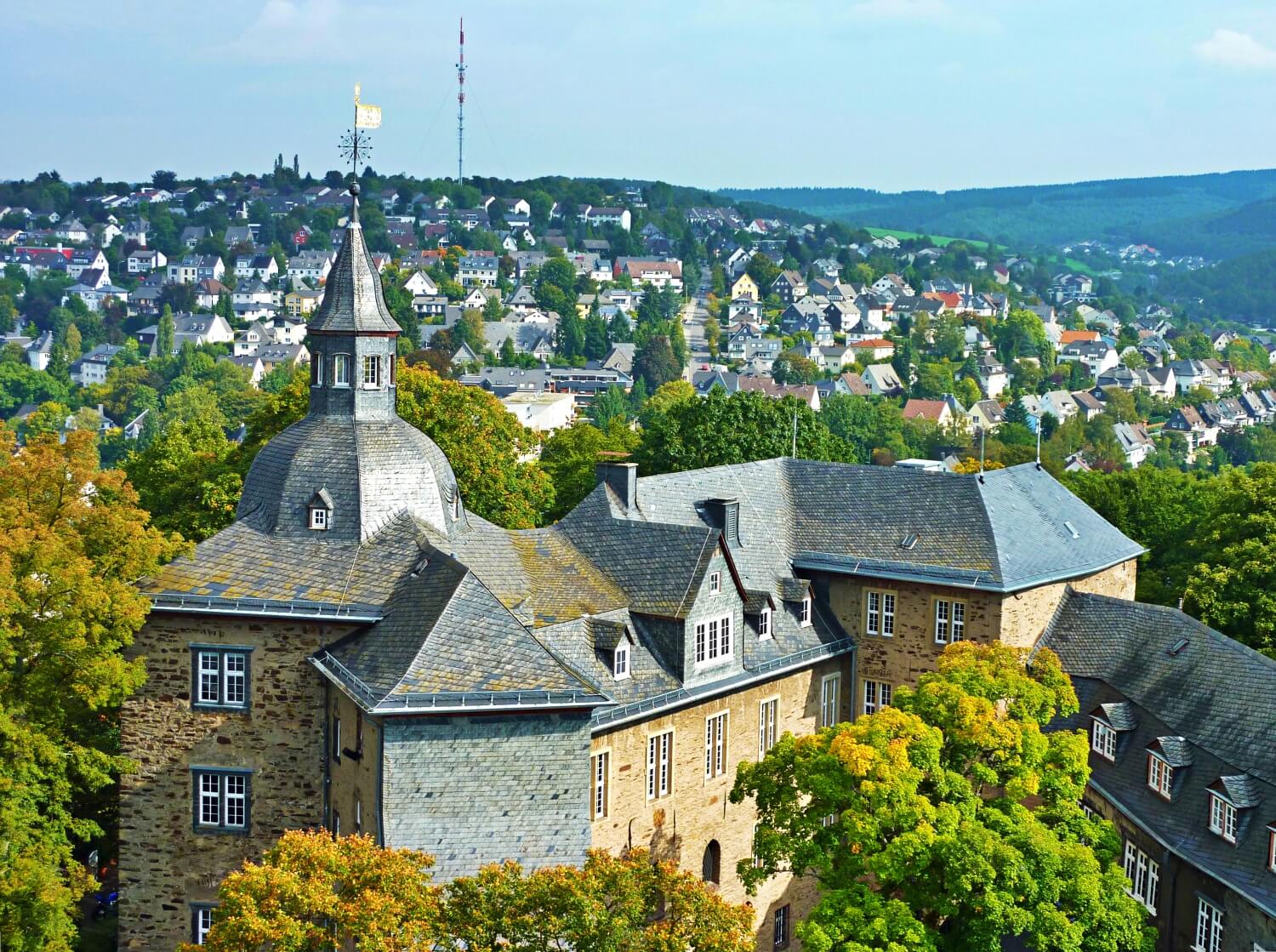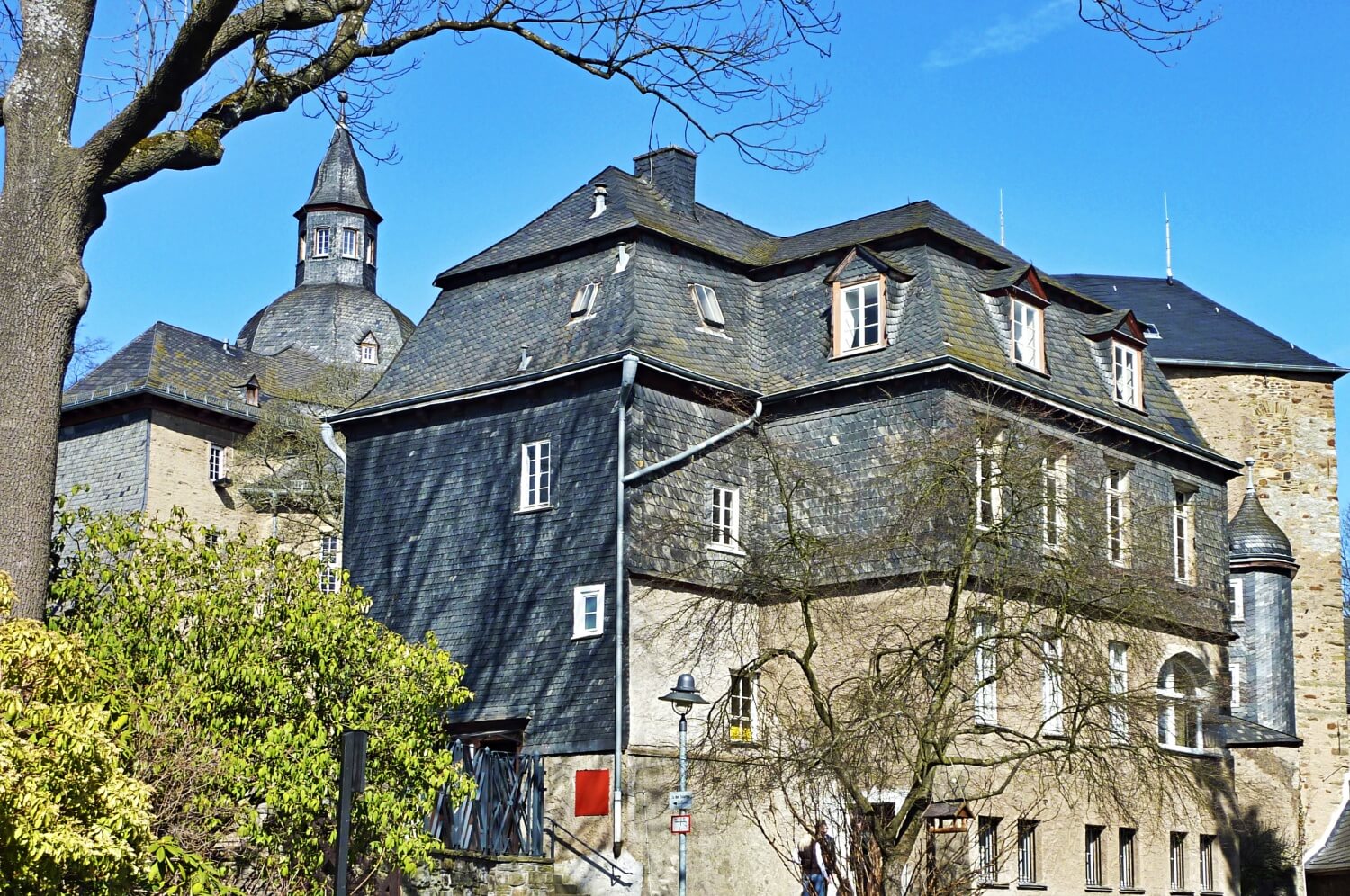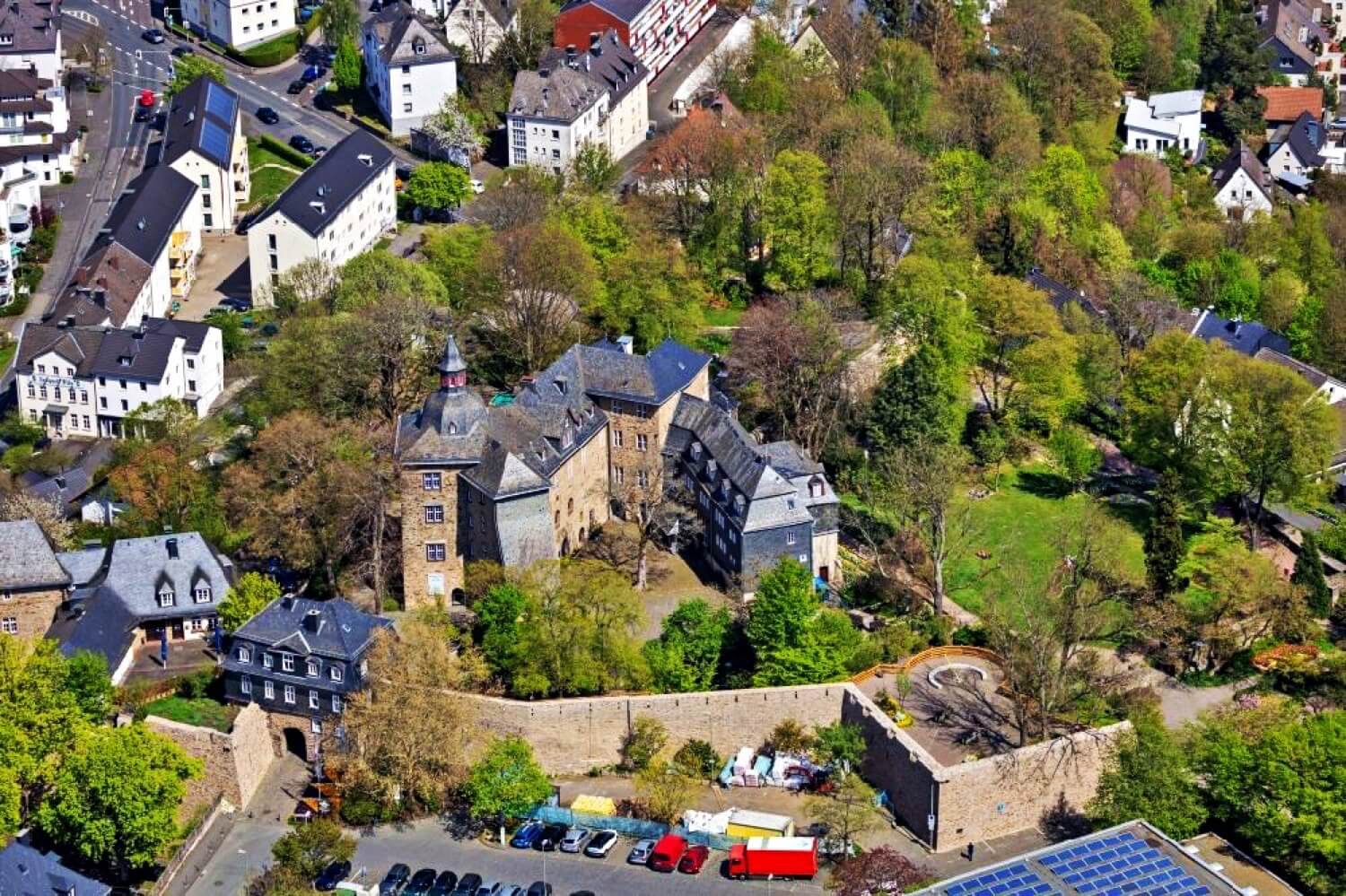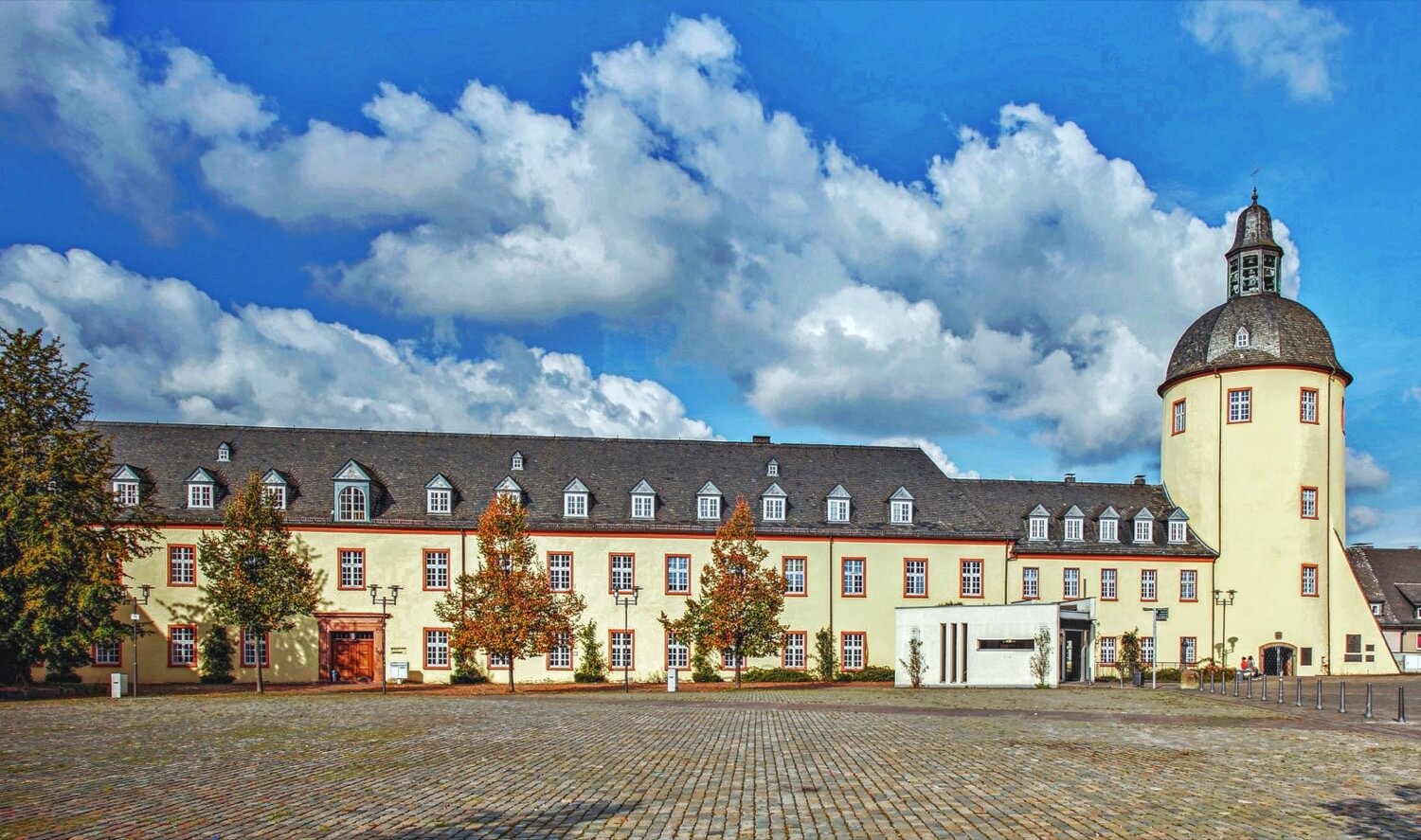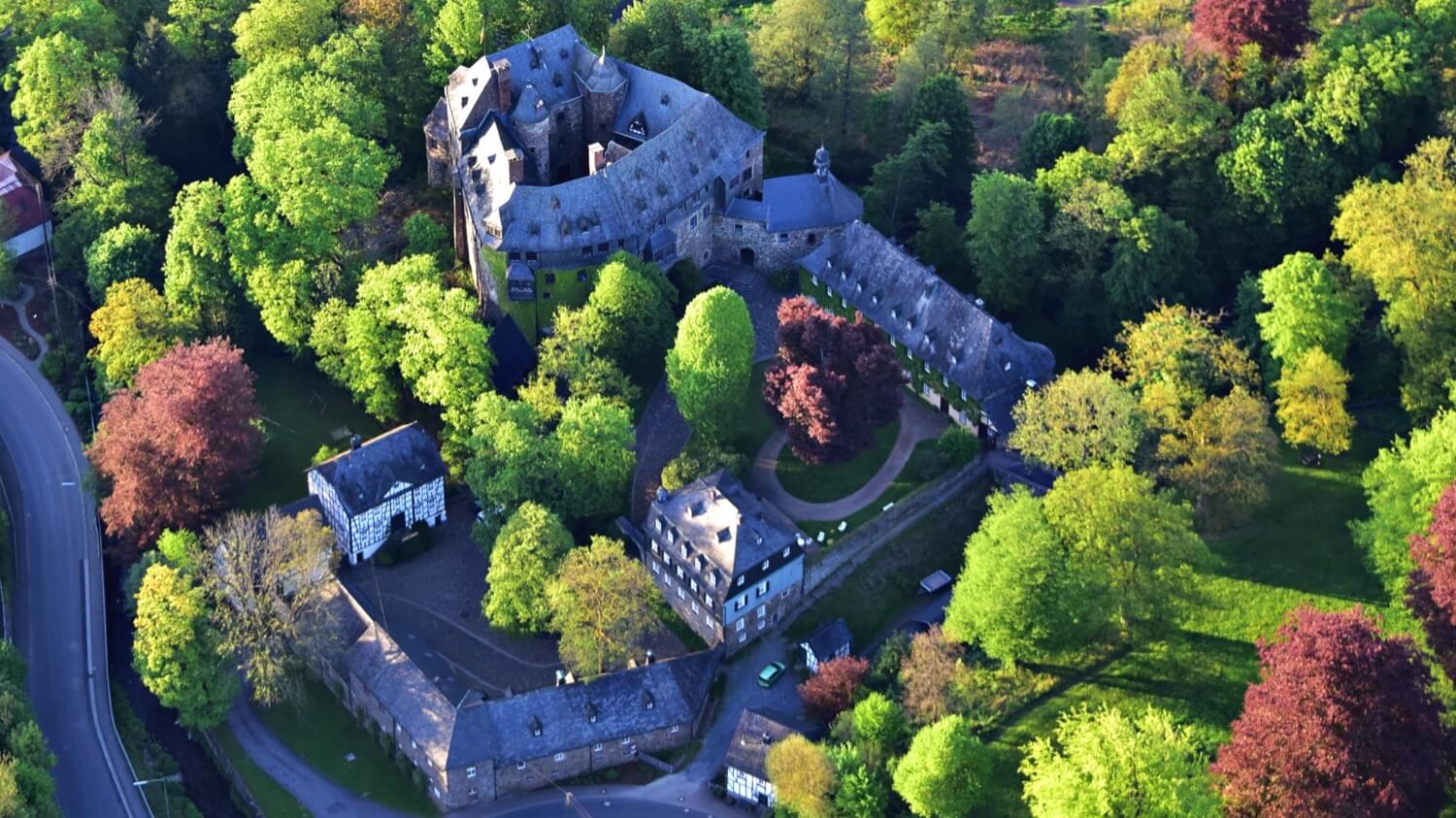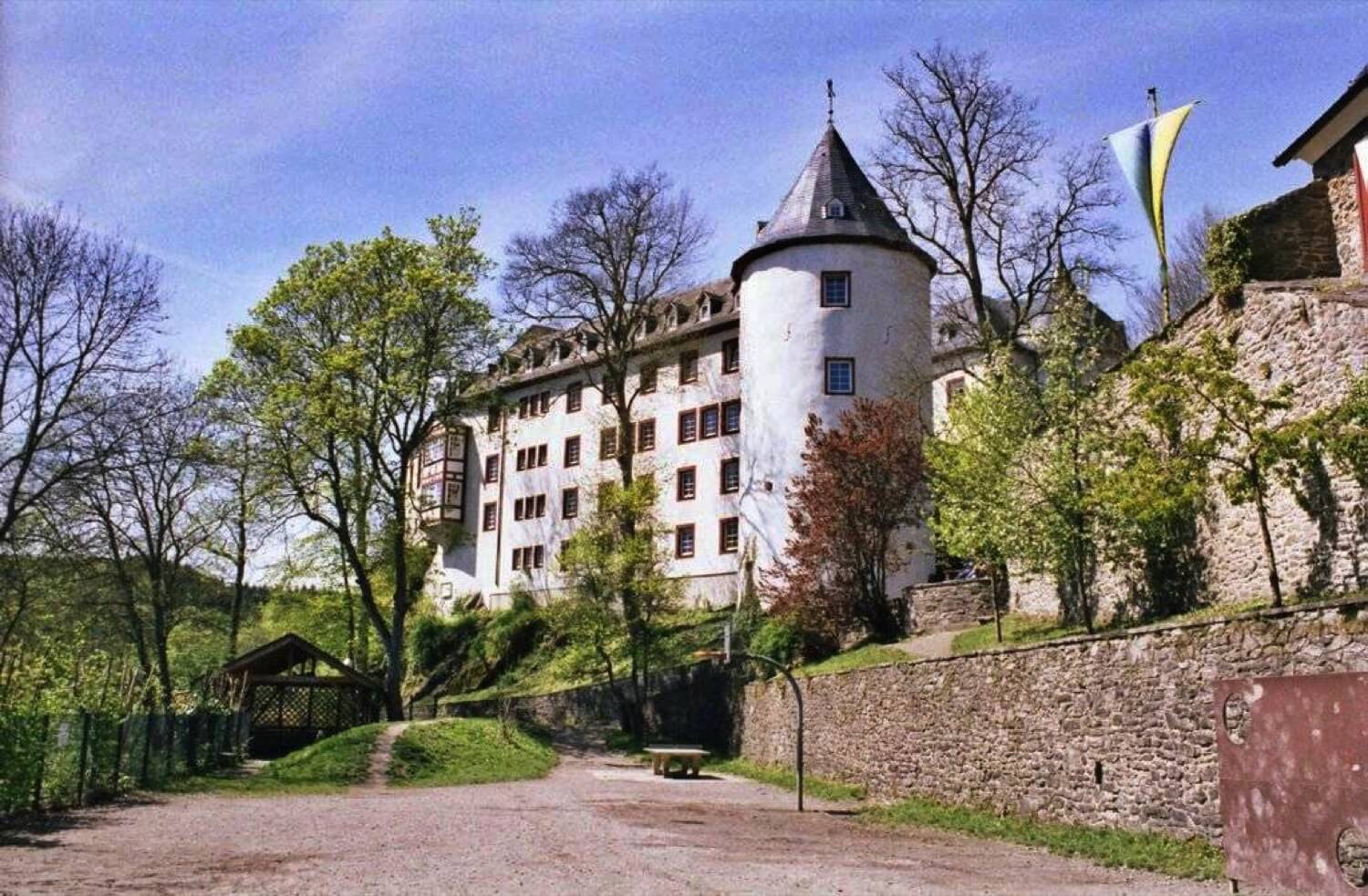Oberes Schloss (Siegen)
Arnsberg Nordrhein-Westfalen Germany
castle, chateau
Oberes Schloss (Siegen)
Arnsberg Nordrhein-Westfalen Germany
castle, chateau
The Oberes Schloss, a medieval fortified hilltop castle, was firstly mentioned in 1259
Das Obere Schloss liegt auf dem 307 m hohen Siegberg in der Stadt Siegen
Previous names
Oberes Schloss (Siegen), Oberes Schloss (Siegen)
Description
The Oberes Schloss, a medieval fortified hilltop castle, was firstly mentioned in 1259. There are, however, other documents which indicate that the castle had already existed in 1224 when Archbishop Engelbert I of Cologne and Count Heinrich II of Nassau, father of the two founders of the main branches of the House of Nassau, divided the town of Siegen among them. Estimations believe that the castle was built around the year 1200.
For the first few centuries, the castle was co-owned by the counts of Nassau and the archbishops of Cologne. The buildings facing the south were occupied by the Nassaus while the north-west facing buildings were owned by the archbishops. The Bischofshaus (bishop's house) was built around 1500 and the original Grafenhaus (count's house) was firstly mentioned in 1343 while today's building one the same site was erected around 1700. Over the years, the influence of the archbishop's decreased steadily and they eventually lost ownership of the castle. After Johann VI of Nassau-Dillenburg died in 1606, his county of Nassau-Dillenburg was divided among his five surviving sons and the third son Johann (VII) received the lands surrounding Siegen. That same year, the Schloss became the main residence of the Siegen branch of the Nassau family.
When Johann VII died in 1628, Nassau-Siegen was divided between his two sons, Johann VIII who had converted to Catholicism and Johann Moritz who remained a Protestant. The castle on the top of the Siegberg hill remained with the Catholic son, the Protestant one built another castle on the foot of the mountain. Around 1700, the hilltop castle became known as the Oberes Schloss (upper castle) while the one below was called Unteres Schloss (lower castle) - very creative, eh?! The Oberes Schloss remained in the hands of the Catholic line until 1743 when they died out in male line after the Protestant line had already done so in 1722. All the Siegen possession were subsequently inherited by the Nassau-Dietz branch which today is better known as the House of Orange-Nassau.
The Rheinbundakte, the 1806 treaty creating the Confederation of the Rhine, mediatised Nassau-Siegen and placed it under the sovereignty of the newly created Grand Duchy of Berg. Two years later, Prince Willem VI of Orange-Nassau lost his remaining German possessions due to his opposition to Napoleon only to regain his territories after the Battle of Leipzig in 1813. Two years later, he ceded his German possession to Prussia to gain their support for the creation of the United Kingdom of the Netherlands of which he eventually became King Willem I.
In 1888, the state of Prussia sold the castle, which had been used by different administrative bodies since the end of the Nassau-Siegen branch, to the town of Siegen. The Siegerlandmuseum, a regional history museum, was opened in 1905. As a result of its changing history in the past 200 years, the Oberes Schloss is still open to the public though it isn't your typical former noble residence anymore. Instead a museum featuring all kinds of local history including a few paintings by Peter Paul Rubens can be found within its walls.
In case you decide that the museum isn't worth visiting, still make sure to make the way up the hill to the Oberes Schloss if you should ever visit Siegen as it has quite a lovely park surrounding it, which usually full of people whenever the weather is good, and offers great views over the Sieg valley.
https://www.castleholic.com
Das Obere Schloss liegt auf dem 307 m hohen Siegberg in der Stadt Siegen. Die Anlage geht auf eine mittelalterliche Höhenburg zurück, die anfangs in gemeinschaftlichem Besitz der Erzbischöfe von Köln und der Grafen von Nassau war. Später ging sie ganz in nassauischen Besitz über. Teilweise umgebaut diente sie zeitweise als Residenz. Heute beherbergt die Anlage das Siegerlandmuseum.
Geschichte
Erstmals urkundlich erwähnt wurde die Anlage in einer auf den 2. September 1259 datierten Urkunde im Namen von Bischof Heinrich von Lüttich als burch inde der stad zen Sigin. Aus einem weiteren Schriftstück aus dem Jahr 1261 lässt sich auf das Bestehen der Burg bereits seit mindestens dem Jahr 1224 schließen – zu dem Zeitpunkt als Graf Heinrich II. von Nassau und Erzbischof Engelbert I. von Köln die Stadt Siegen untereinander aufteilten. Die Errichtung der Burg wird bereits für die Zeit um das Jahr 1200 vermutet. Die ersten urkundlichen Erwähnungen lassen jedoch noch keine Schlüsse auf Größe und Aufbau der Burg zu. Eine Urkunde von 1341 erwähnt lediglich die „vestin Sigin, Ginsberg unde der Han“. Erst ein weiterer Vertrag aus dem Jahr 1343 gibt durch präzisere Dokumentation der seit 1224 bestehenden Aufteilung Hinweise auf die Beschaffenheit der Gebäude. So waren zwei Pforten, Hauptturm sowie Innenhof mit Brunnen im gemeinschaftlichen Besitz. Die Gebäude zur Sieg hin waren erzbischöflich („Bischofshaus“), während die Gebäude zur Weiß hin gräflich waren („Grafenhaus“). Im Laufe der Zeit nahm der erzbischöfliche Einfluss immer mehr ab. Bis ins späte 15. Jahrhundert wurde die Anlage in Schriftstücken als Burg („burch“), Festung („vestin“) oder auch mit dem lateinischen Begriff für Burg, castrum bezeichnet; erst danach setzte sich allmählich die Bezeichnung als Schloss durch. Seit 1670 wird die Anlage Altes Schloss beziehungsweise Oberes Schloss genannt.
Zu Beginn des 15. Jahrhunderts waren die Grafen von Nassau alleinige Stadt- und Burgherren. Die Aufhebung der Zweiteilung der Burg ist für das Jahr 1421 überliefert. Im Spätmittelalter wurde die Anlage ausgebaut und stärker mit Wehrtürmen und Mauern befestigt. Ein Brand, ausgelöst durch einen Blitzschlag, zerstörte am 19. Juli 1503 große Teile der zentralen Gebäude. Im Rahmen des Wiederaufbaus ab dem Jahr 1506 entstanden unter anderem die Gotische Halle und der Oraniersaal. Während des 16. bis ins frühe 17. Jahrhundert diente die Burg nur gelegentlich als Residenz der Grafen. Nach der Aufteilung der nassauischen Besitzungen wurde Johann der Mittlere Regent im Siegerland. Seither diente die Burg als Residenz des Hauses Nassau-Siegen.
Wegen konfessioneller Streitigkeiten kam es 1623 zu einer weiteren Aufteilung. Die evangelische Linie residierte im ehemaligen Franziskanerkloster, das sich später zum Unteren Schloss entwickelte. Das Obere Schloss blieb in der Hand der katholischen Linie. Die konfessionellen Konflikte waren erst im 18. Jahrhundert beendet. Im Jahr 1742 gelangten alle nördlich der Lahn gelegenen Besitzungen des Hauses Nassau an die Linie Nassau-Dietz, das seit 1747 auch die Erbstatthalter der Niederlande stellte. Damit verlor Siegen seine Residenzfunktion. Es wurde Sitz eines Amtmannes.
Unter den folgenden wechselnden Landesherren bis in die preußische Zeit war das Obere Schloss Sitz verschiedener Behörden wie Landratsamt und Domänenverwaltung. Seit 1888 gehört das Schloss der Stadt Siegen. Seit 1905 beherbergt es das Siegerlandmuseum.
Nutzung seit dem 20. Jahrhundert
Siegerlandmuseum
Im Jahr 1888 erwarb die Stadt Siegen das Obere Schloss zum „verhältnismäßig günstigen“ Preis von 30.400 Mark vom Königreich Preußen und richtete dort im Jahr 1905 das Siegerlandmuseum ein, ein Museum für die regionale Geschichte. Die Einweihung fand am 25. März 1905 statt. Die Aufgabe des Museums sollte es sein, „das Wesen der Siegerländer Heimat nach Geschichte, Kultur und Volkstum darzustellen“. Das Museum hatte mit nur drei Ausstellungsräumen im Schloss begonnen; im Jahr 1929 erstreckte es sich bereits auf 35 Räume. Gegenwärtig verfügt das Museum über etwa 1.500 m² Ausstellungsfläche. Die Ausstellungsräume beherbergen unter anderem eine der wichtigsten Porträtsammlungen der Häuser Nassau und Oranien. Im Rubens-Saal sind neun Original-Gemälde des Barockmalers Peter Paul Rubens dauerhaft ausgestellt, darunter eine Fassung seines bekannten Werks Der Raub der Töchter des Leukippos sowie die erste Fassung seines Gemäldes Kreuzabnahme, die den Beginn seiner Karriere in Italien markiert. Zu den bedeutendsten Räumen des Museums zählt außerdem die Gotische Halle aus dem 14. Jahrhundert mit einer im Original erhaltenen Fußbodenpflasterung aus Grauwackensteinen im Fischgrätmuster. Weitere Räume sind berühmten Persönlichkeiten aus dem Siegerland gewidmet, darunter der Arzt und Schriftsteller Johann Heinrich Jung-Stilling und die Musikerfamilie Gebrüder Busch. Unter dem Schlosshof wurde im Jahr 1938 in 14 Meter Tiefe ein Schaubergwerk eingerichtet, das auf etwa 150 Meter Stollenlänge originale Einrichtungen und Ausstattung eines Siegerländer Erzbergwerks zeigt. Eröffnet wurde das Schaubergwerk am 8. Juli 1938 beim Westfalentag in Siegen. Neben der Dauerausstellung finden im Museum regelmäßig Wechselausstellungen statt. Alleiniger Träger des Siegerlandmuseums ist seit 1981 die Stadt Siegen. Geleitet wird das Museum seit 1991 von Ursula Blanchebarbe. Vorgänger in dieser Position waren unter anderem Wilhelm Weyer im Zeitraum von 1946 bis 1949 oder Bernd Roedig. Im Schloss befindet sich ebenfalls die wissenschaftliche Stadtbibliothek (Siegerlandbibliothek).
Schlosspark und Peripherie
Der flächenmäßig größte Teil des Schlossgrundstücks wird vom Schlosspark eingenommen, der hauptsächlich als Ziergarten mit großflächigen Blumenrabatten dient, davon etwa 60.000 Tulpen. Im Schlosspark sind mehrere zeitgenössische Skulpturen dauerhaft ausgestellt, darunter der Rubensbrunnen mit einer Plastik des Bildhauers Hermann Kuhmichel, der an die Geburt des 1577 in Siegen geborenen Peter Paul Rubens erinnert. Unter einer Zeltdachkonstruktion in der südlichen Hälfte des Parks finden in den Sommermonaten regelmäßig kulturelle Veranstaltungen – Konzerte und Theateraufführungen – statt. Außerdem befinden sich auf dem Gelände ein Café-Restaurant sowie ein Kinderspielplatz. Das Zeughaus unmittelbar vor dem Schlossgelände wird gegenwärtig als Studentenwohnheim genutzt und beherbergt im Erdgeschoss außerdem eine Gaststätte.
In der Zeit des Nationalsozialismus wurden am südlichen Teil des Schlossparks zwei Hochbunker für den zivilen Luftschutz errichtet, die teilweise in die historischen Befestigungsanlagen integriert wurden. Ein dritter Luftschutzbunker mit zwei einzelnen Bauten entstand auf dem Gelände der Burgfreiheit an der Nordseite der Burgstraße. Zu Tarnungszwecken wurde das äußere Erscheinungsbild der Gebäude teilweise an die Architektur des Oberen Schlosses angelehnt. Zusammengenommen hatten die Bunkeranlagen eine Platzkapazität von Sitz- und Liegeplätzen für etwa 3000 Personen. Nach dem Ende des Zweiten Weltkriegs wurden bei zweien der Bunker die Obergeschosse in privaten Wohnraum umgewandelt, der bis in die Gegenwart benutzt wird.
Useful information
0.60 EUR/Stunde
3.50 EUR
Premium-Sonderausstellungen: 4.00 EUR
Kinder: 1.50 EUR
0 - 6 Jahre: gratis
ab 10 Personen: 2.50 EUR
Familie: 6.00 EUR
- WC
- Schlosspark
u.blanchebarbe@siegen.de
- Es beherbergt das Siegerland Museum
- Für Rollstühle nicht zugänglich
- Räume zu vermieten
- Montags geschlossen
- Führungen nach Vereinbarung
-
External links
Nearby castles
